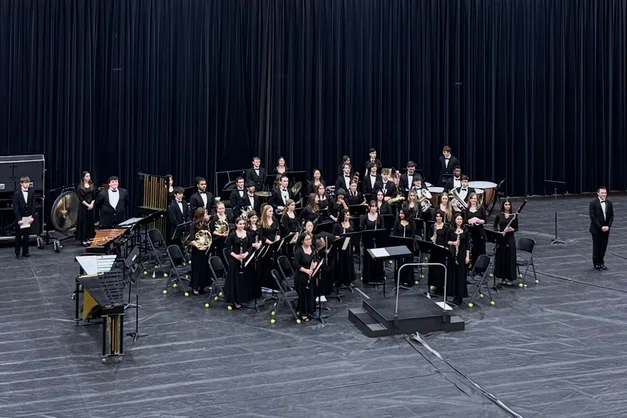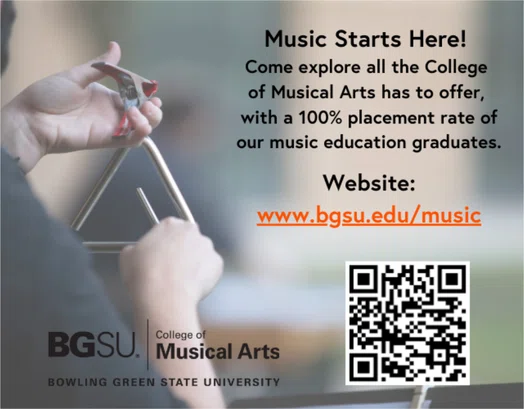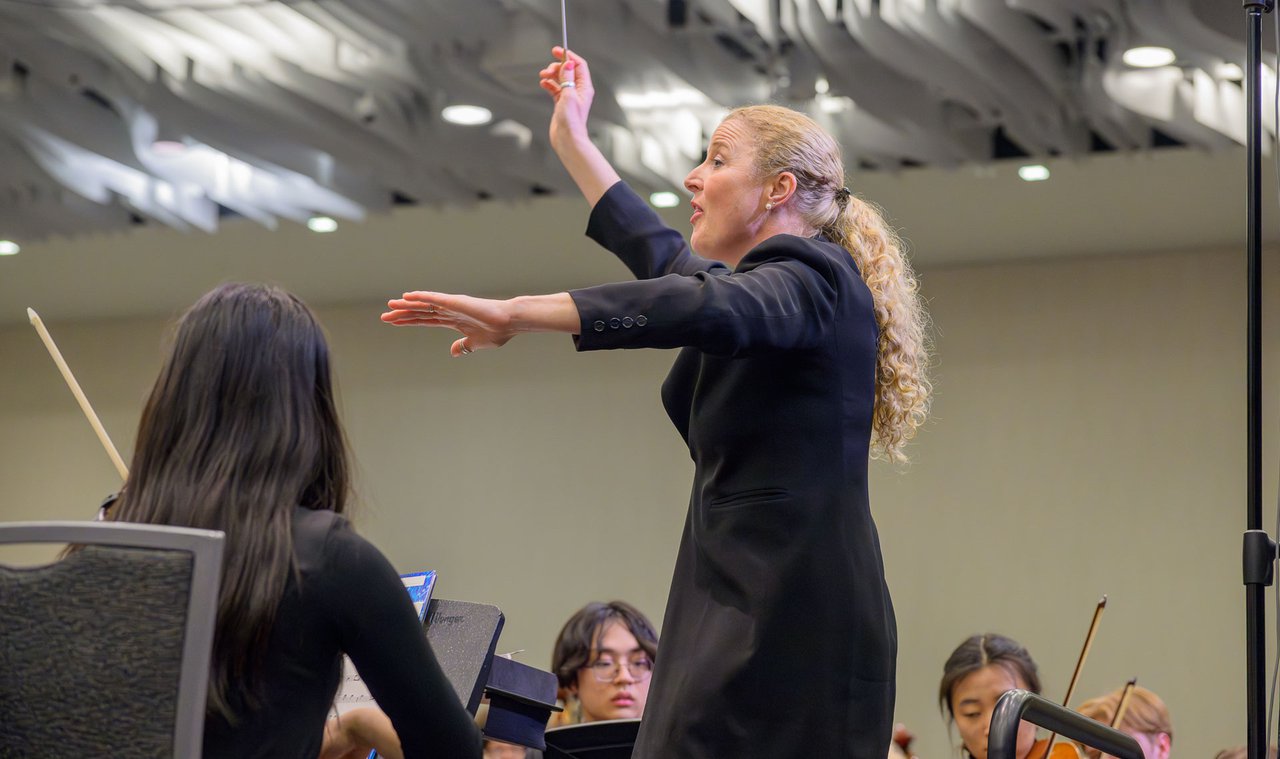©2025 Ohio Music Education Association



Being the director of an ensemble of any age or ability level comes with a great amount of responsibility. Our job starts with choosing appropriate, challenging, and varied repertoire and setting a timeline for achieving the highest level of performance in time for the concert. In order to reach the latter, our daily responsibilities lie with two priorities: rehearsal pacing and feedback. If we want to help our musicians grow then we need to have them making music as much as possible as well as making adjustments based on our feedback. But if we’re supposed to dedicate the majority of rehearsal to their music making, then when are we supposed to give that feedback?
Most directors choose one of two things to give feedback: one way is to stop the music making in order to give verbal feedback, which can have a negative effect on the rehearsal pacing and off-task behavior (Yarbrough & Madsen, 1998). Stopping the ensemble to give them feedback is not necessarily a bad idea, in fact it is widely agreed upon that specific, verbal feedback is best practice (Cavitt, 2003; Duke, 2000; Goolsby, 1997; Siebenaler, 1997), but some directors are simply unaware of how much time they spend talking during rehearsal (Nápoles & Vázquez-Ramos, 2013). The less time you spend talking, the more time the students can spend making music.

Canfield Symphonic Band
The second choice that most directors make is that they shout their verbal feedback over the ensemble as they are singing, which can cause voice related injury or stress (Brown, 2016). The hazard of this behavior is that directors are often giving their feedback over a “very loud” classroom. According to the American Speech and Hearing Association, a “very loud” classroom is >80dBA, which is essentially equivalent to trying to give directions or feedback over the sound of a garbage disposal. Brown (2016) found that teachers with voice related injury shout/give verbal feedback over “very loud” sounds of their ensemble seven times more often than teachers without voice related injury.
It is unrealistic to think that directors will never stop rehearsal to give feedback or never give verbal commands while the students are making music. Sometimes directors need to stop the rehearsal because they need to fix an egregious error immediately or they are afraid that if you do not stop right away that they will forget what they wanted to address. Other times directors will hear something that causes a visceral reaction that leads to a verbal outburst such as “WOW!” or “Nope! Fix it!” which are often given while the ensemble is still making music. Regardless of the verbal feedback or its delivery system, directors often use a non-verbal gesture along with the verbal that delivers the same information. If we as directors can remove some of the verbal commands and replace them with non-verbal gesture, it could help keep a strong rehearsal pace as well as avoid potential vocal fatigue or injury.
Canfield Concert Band
Non-verbal gestures can easily be incorporated into your rehearsal in order to reinforce both approval and disapproval, based on what the ensemble is doing in real time. The added benefit of giving pivotal information through non-verbal gesture is that it forces your students to look at you during rehearsal and forces that director-student connection that can be so vital to the music making experience. The following chart offers some of the non-verbal gestures that you could start to incorporate into your rehearsals.
Non-verbal approval
Non-verbal disapproval
- Thumbs-up
- Smiling
- Head nodding
- Hands up in the air (as if to say “thank you” or “touchdown”)
- Fist bump
- Hand clapping
- Hand over heart (conveying that you felt moved by the music)
- Hugging or embracing oneself (as if to say that you love what you hear)
- Winking at a section
- Pointing upwards with raised eyebrows (conveying that the students are flat)
- Pointing downwards (conveying that the students are sharp)
- A negative facial expression, such as furrowed eyebrows
- Shaking head left and right as if to say “no”
- Physically moving closer to or pointing at a section (as if to say “pay attention”)
- Put hand to ear (conveying that there is imbalance amongst the sections or that a section can not be heard)
- Strong, glaring eye contact with one student
- Arms crossed in disapproval
- Pointer finger over mouth (conveying that the section is too loud)
Other music-specific non-verbal gestures can be conveyed through traditional conducting techniques. Conductors can easily show expression (crescendo, decrescendo, legato, staccato) dynamics (piano, forte) and technique (string bowing technique, vowel/vocal placement), but it’s the non-musical gestures, such as the ones listed above, that can be equally important when trying to shape a musical moment.
Non-verbal gesture can be very helpful to deliver information quickly to your ensemble without sacrificing pacing, but can often lack specificity. A smile directed towards the Soprano section generally expresses approval, but of what specifically can get lost in translation. It is most appropriate, then, to use those natural pauses in the rehearsal (such as the end of the phrase or piece) to add specific verbal feedback to help clarify the meaning of your non-verbal gesture before moving on to your next task. Conversely, if you give your Tenors “the look” or another gesture of disapproval, then it is imperative that you address the specifics of that disapproval in order to fix it. Specific, verbal feedback is often necessary in order to address particular needs within the music, but if you can also use non-verbal feedback without sacrificing pacing, the amount of time students spend making music, all while reinforcing that the ensemble need to be looking at the director, then it can only enhance your rehearsal and lead towards a more efficient use of time.
Biddlecombe, T. (2012). Assessing and enhancing feedback of choral conductors through analysis and training. International Journal of Research in Choral Singing, 4, 2-18.
Brown, E. P. (2016). Behavioral and environmental analysis of self-reported dysphonic and non-dysphonic high school music teachers.
Cavitt, M. E. (2003). A descriptive analysis of error correction in instrumental music rehearsals. Journal of Research in Music Education, 51(3), pp. 218-230.
Duke, R. A. (2000). Measures of instructional effectiveness in music research. Bulletin of the Council for Research in Music Education, 143, 1-48.
Goolsby, T. W. (1997). Verbal instruction in instrumental rehearsals: A comparison of three career levels and preservice teachers. Journal of Research in Music Education, 45(1), 20– 40.
Nápoles, J., & Vázquez-Ramos, A. M. (2013). Perceptions of time spent in teacher talk: a comparison among self-estimates, peer estimates, and actual time. Journal of Research in Music Education, 60(4), 452-461.
Siebenaler, D. J. (1997). Analysis of teacher-student interactions in the piano lessons of children and adults. Journal of Research in Music Education, 45(6), 6-20.
Yarbrough, C., & Madsen, K. (1998). The evaluation of teaching in choral rehearsals. Journal of Research in Music Education, 46(4), 469-481.





